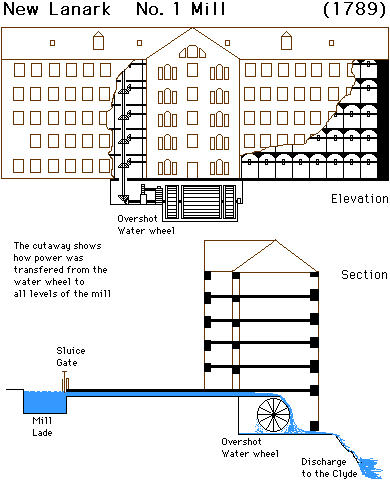Scottish landscapes, gardens and waterfalls
The Falls of the Clyde, New Lanark Mills
18th Century water-powered Cotton Mills
While poets and artists and tourists in search of the sublime came and went, two visitors in 1783 looked at the falls with a different eye. David Dale, son of a grocer, and prosperous cloth merchant accompanied by Richard Arkwright wondered if the power of all this water could be harnessed to drive cotton spinning machines. Arkwright had invented one called "the water-frame" which needed too much power to be used by an individual family (as was common with spinning machines and looms at the time). They wanted to incorporate hundreds of these machines in one location and use a common source of power to drive them all.

Within ten years Dale built a new village, (eventually 2500 people lived and worked there) called New Lanark, centered around his new mill factories. It is difficult to appreciate the impact these must have had at the time; many of the families who worked in them came from the Highlands looking for a better life after the clearances and must surely never have seen buildings so large with so many floors.
Robert Owen's Revolutionary Philosophy
New Lanark made good profits. Dale's daughter married Robert Owen who took over the running of the mill. Owen's life's ambition was to benefit humanity, not only through productivity and profits, but also by bettering the lot of his employees.

In an age when children were often illiterate and exploited he introduced the idea of education for all and the then revolutionary idea that children should not be allowed to work in the mills before the age of ten. In 1809 he established Nursery Buildings to improve living conditions of children and apprentices, and in 1816 The Institute for the Formation of Character, at first a school and later religious meeting place, dance and concert hall. in 1817 The School for Children was founded for the education of children between the ages of one and ten. Revolutionary for the time, the school's ethic was based on Owen's philosophy of "rational approach"; there was no punishment only encouragement and kindness. Teaching aids such as large coloured canvasses, and singing and dancing complemented Reading Writing and Arithmetic, and the children assembled every working day in cotton Highland or Roman dress.
12 Teachers taught 194 children in Elementary school, and 7 taught 80 in the Infant School... a good teacher- pupil ratio even by today's standards.
New Buildings

New Buildings was built in 1798 by David Dale. Above the central classical pediment is a tower containing a bell inscribed "Hagarston, Washington County, Lutheran Congregation, Glasgow - Maryland 1786." A ship bound for America with Highlander emigrants from Skye was held up in port by very bad weather. Dale persuaded them to come and work in his mills at New Lanark, and the bell they were taking to the new world came too.
A Complete Village

New Lanark became world renowned as one of the earliest experiments in creating a civilised working environment and improved living conditions for a workforce as part of a large scale mechanised industrial process. Apart from the schools and religious meeting places, comfortable terraced houses were eventually built for the workers and their families, gas lighting was provided, cleanliness encouraged and a village store set up.
In recent years the mill declined and was finally abandoned. The New Lanark Conservation Trust was set up which has restored the whole village. It is now open for visitors. The richly wooded surrounding area with its sandstone gorges and dramatic waterfalls is now the Falls of Clyde Nature Reserve.

Stuart Glen of the Scottish Wildlife Trust says:
"The Falls of Clyde is owned by the Scottish Wildlife Trust, Scotland's leading wildlife conservation organisation. It is in fact a wildlife reserve, one of over 120 reserves we own. It is a spectacular reserve with unrivalled opportunities to view peregrine falcons, badgers and bats. The ranger service offers an extensive summer events programme of guided walks. Check out our own website at http://www.swt.org.uk - then follow the reserves heading to find Falls of Clyde - to get a feel for the place."
Please check with The New Lanark Conservation Trust +44 1555 661345 about opening times before visiting the Mills and village. The Falls may be visited at all times.

Right;
Mill buildings on the banks of the Clyde, Detail of a Water Wheel.
